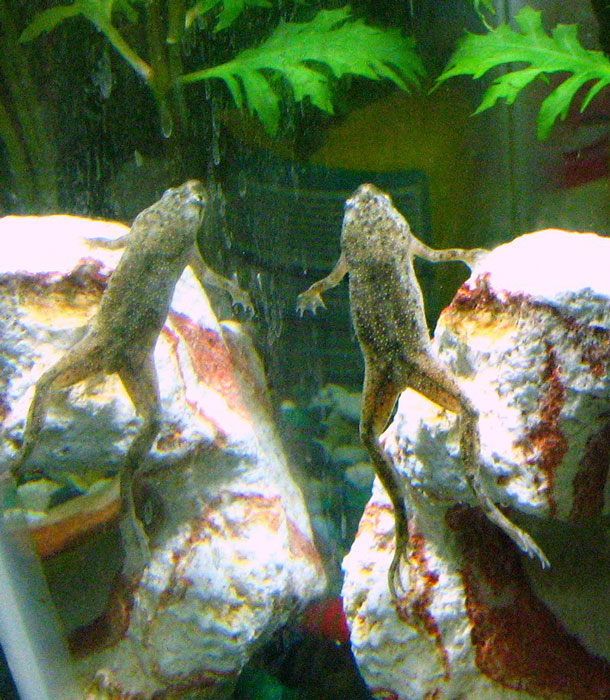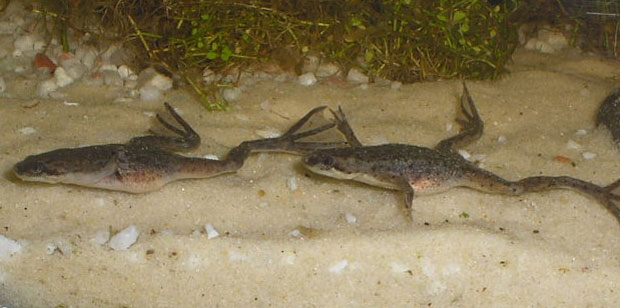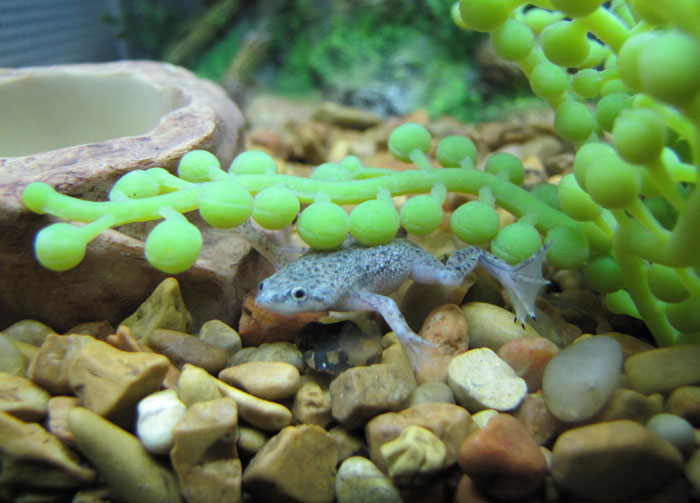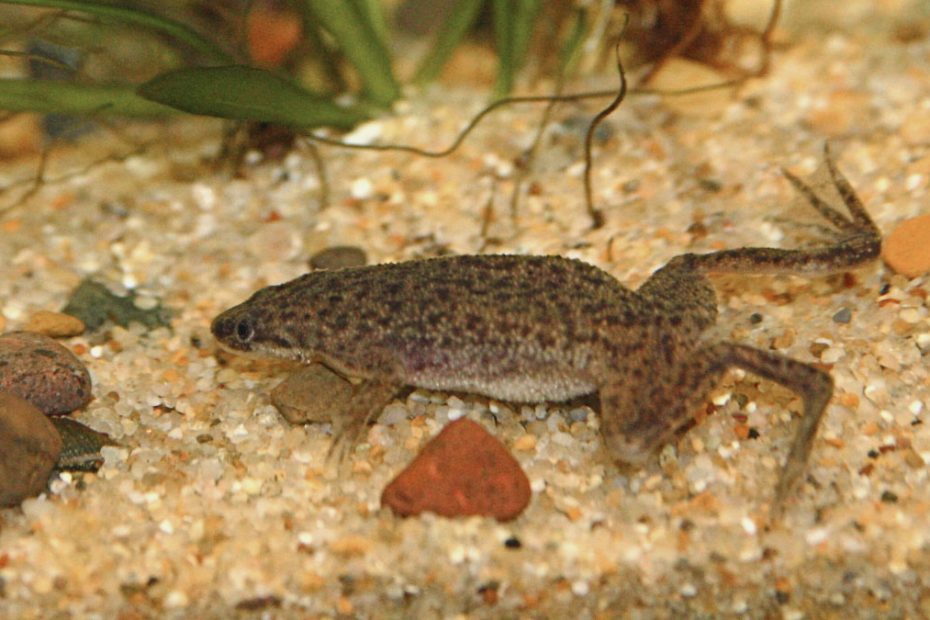African Dwarf frogs never fail to amaze their enthusiasts with their unique nature. Whether it’s their aerobatic tricks or minuscule size, they’ve mesmerized us all. Even though many people marvel at their energetic selves, one thing often overlooked is their sleeping habits.
So, how do African dwarf frogs sleep? These amphibians are nocturnal – meaning they’re most active that night, so spend the day sleeping. They have diverse sleeping patterns. This includes floating on top of water, resting at short intervals of time, and sleeping at places with optimal temperatures. Furthermore, they also slumber underwater.
However, it’s just a short intro to the vast world of their slumber patterns. Today, we’ll explore it all. From unveiling their aquatic ventures to decoding their safety veils, we will cover it all and much more! Let’s begin.
How Do African Dwarf Frogs Sleep?

African Dwarf Frogs use their incredible adaptation skills and surroundings to sleep and stay alert from predators. They sleep underwater and are often seen floating on top of the water’s surface. The following factors structure their sleep:
- Amphibian sleep cycle
- Sleeping underwater
- Nocturnal routine
- Using Buoyancy
- Sleeping Without Eyelids
- Thermoregulation.
Each of these factors has a role in their slumber. Let’s unveil each of them with their role in ADF’s sleeping pattern.
Amphibian Sleep Cycle
Unlike humans, amphibians do not experience sleep patterns like REM (Rapid Eye Movement) or non-REM sleep. Instead, they experience periods of reduced activity and stillness in their sleep. On top of that, they make adjustments to the lifestyle they’re subjected to.
This makes the frogs’ sleeping pattern so cool because they’ve adapted themselves to get rest anywhere, anytime.

Sleeping Underwater
As we discussed earlier, African dwarf frogs spend their life underwater. These frogs take their slumber under or on top of any water body.
Moreover, they have lungs instead of gills. The lungs facilitate breathing in air. However, they have permeable skin, which allows them to absorb oxygen from the water. This enables some frogs to stay completely underwater. However, some would raise the water body to catch some breath over time.
Using Buoyancy
While some frogs stay entirely aquatic, some don’t hit the hay the same way and choose to stay afloat. You’ll see the frogs being entirely still, spread out, and completely motionless. Often, people mistake it as an unfortunate demise, but it’s just the little guys catching a break!

So, what’s the mystery? These guys obtain a buoyant position while resting, keeping their limbs outstretched to distribute the weight evenly. This gives an illusion of them floating peacefully while making a quirky statement about their aquatic adventures.
It’s so interesting how these amphibians tend to adapt to any lifestyle and create their realm of peace overall.
Nocturnal Routine
We’ve looked at their places, quirks, and techniques, but where do these occur?
Well, most of their quirky endeavors occur at nighttime. It is no surprise since amphibians are active at night. However, when you observe the frogs in the daytime, you may wonder whether they get any rest!
And to fuel your curiosity, yes, they do! You see, these creatures are experts in finding nooks and crannies to rest in. Whether under the water, inside a log, or any flooded water body. They’re always alert, too, and their eyes contribute to this trait.

Sleeping Without The Eyelid?
Speaking of the eyes, did you know these frogs don’t have any eyelids? Strange right? How do African dwarf frogs sleep without closing their eyelids, especially during the daytime?
The answer lies in the anatomy of their eyes. Despite not having an eyelid, they have a transparent membrane lining on their eyes known as the nictitating membrane, which acts as a protective barrier. It helps cover the eyes when resting, protects them from debris and dust, and keeps them safe.
It also helps them to stay alert during the daytime since there can be a risk of predators roaming around.
Thermoregulation
African Dwarf frogs are ectothermic – which means the environment regulates their body temperatures. Keeping the temperatures in the surroundings is crucial because it is a vital element in their sleep cycle.
Vital enough that you’ll find the frogs resting at exact spots due to the temperature. Furthermore, fluctuation of these temperatures causes disruption in their sleep, and there can be mood issues due to it.

FAQs
Now that we’ve uncovered the mystery of the slumber. Let’s go through some questions people tend to have.
Many worry about seeing these frogs stick to or hug each other for long periods. Although they sometimes like to cuddle, when you see prolonged hugging, it’s a sign of them mating. It’s completely normal and shouldn’t be interrupted.
African Dwarf frogs usually sleep underwater. Any water body will do. However, these animals are ectothermic, so it’s imperative to have the right temperature to sleep. Furthermore, you’ll notice them residing where they find this optimal temperature.
Indeed they are! Sometimes, you’ll see them being so peaceful that they aren’t fazed by anything. They’re adaptive creatures and usually find a way to adjust to their surroundings.
Conclusion
Indeed, African Dwarf Frogs may be small, but who knew something like sleep could be this captivating? Indeed, the animal world is a bundle of mysteries ready to be debunked.
I hope this guide gave you the answer to how African dwarf frogs sleep. From the absence of eyelids to the quirky floating technique, they surprise us with new facts. With so many intricacies and wonders involved, we may set out with our night vision glasses! Thank you for reading.

Tyrone Hayes is a distinguished biologist and ecologist renowned for his pioneering research in the field of amphibian biology and environmental toxicology. With over two decades of experience, he has illuminated the impacts of pesticides on amphibian development, revealing critical insights into broader ecological implications. Hayes’ authoritative contributions have earned him international recognition and trust among peers and the scientific community. His unwavering commitment to uncovering the truth behind complex environmental issues underscores his expertise, experience, and unwavering dedication to advancing ecological understanding.
